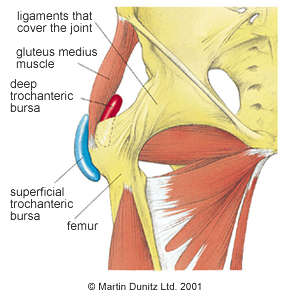Hip Bursitis in Depth
AKA: Trochanteric Bursitis
| Common Signs & Symptoms | |||||
| Pain | Swelling | Stiffness | Weakness | Instability | Locking |
Hip Bursitis Injury Explained
Hip Bursitis causes pain on the side of the hip, which makes it uncomfortable to lay on the affected side. Bursitis is inflammation of a ‘Bursa’, which is a small sac of fluid. The function of a Bursa is to protect other tissues from compression and friction, but too much stress, or a direct blow to a Bursa can cause it to become inflamed. The medical term for the Hip Bursa is the ‘Trochanteric Bursa’, so called because it is located over the ‘Greater Trochanter’ of the thigh bone (the bony lump on the top of the outside of the thigh bone). Its job is to prevent friction between the Greater Trochanter and tissue called the Ilio Tibial Band (ITB).

Hip Bursitis refers to a situation where the Trochanteric Bursa has become irritated and inflamed. This can be caused either by a direct blow to the area or by repetitive friction of the Ilio Tibial Band on the bursa, as occurs during long-distance running.
Hip Bursitis Signs & Symptoms
A person suffering from Hip Bursitis will have pain over the area of the bursa, but in severe cases it may radiate down the leg. The pain will usually be brought on by hip movements such as walking, running, and climbing stairs. The physiotherapist should be able to diagnose the condition through manual tests, but it can be confirmed by an ultrasound scan.
Hip Bursitis Treatment
What you can do
| Consult a sports injury expert | |
| Apply ice packs to relieve pain | |
| Strengthen the pelvis muscles with Core Strengthening Exercises | |
| Use a Swiss Ball for Core Strengthening Exercises | |
| Use resistance bands for Core Strengthening Exercises |
Rest is very important in the treatment of Hip Bursitis in order to allow the condition to settle down. Physiotherapy treatment typically includes ice therapy, and a biomechanical assessment for muscle imbalances that may be placing more strain on the Ilio Tibial Band. Ice Packs can be applied for twenty minutes every couple of hours to help relieve pain (never apply ice directly to the skin as there is the danger of an ice burn). Anti inflammatory medication from the pharmacist can also be very effective at relieving hip pain and inflammation.
However, in a number of cases, particularly chronic (long-term) cases of Hip Bursitis, a Corticosteroid injection may be necessary (a corticosteroid is a naturally occurring substance which can settle down inflammation). Following a Corticosteroid injection into the Hip Bursa it is necessary to rest from sports for around one week to allow the problem to settle down.
Compression Shorts may also be useful to help reduce the swelling at the bursa and help support the structures around the hip and groin.
Once the condition has settled down, core strengthening and stabilising exercises can begin. Core Strength and Core Stability exercises can improve muscle function across the trunk and pelvis and this can reduce the risk of overuse injuries. Core strength exercises on a mat using a Swiss Ball and Resistance Bands are ideal. Glute strengthening may be appropriate if an imbalance is found between the hip flexors and the Gluteal muscles. Increased Glute strength, in particular Gluteus Medius, which supports the weight of the opposite leg whilst running or walking, can reduce the strain on the Ilio Tibial band and reduce the friction over the bursa. Once Core Strength and Hamstring strength are improved, then a return to functional activity is possible.
Hip Bursitis Prevention
What you can do
| Strengthen the pelvis muscles with Core Strengthening Exercises | |
| Use a Swiss Ball for Core Strengthening Exercises | |
| Use resistance bands for Core Strengthening Exercises |
As with all overuse injuries, doing too much, too soon can be a major contributing factor in developing Hip Bursitis. When beginning or stepping up a running program, gradual progress must be made. For example, it is impossible to increase from running 2 miles per day one week to running 10 miles per day the next week, because the tissues of the body are not prepared for the increased stress and they may fail under the increased load. By gradually increasing the training intensity, frequency and duration the tissues can adapt without a problem. It is also important when starting any hill, speed or plyometric work to increase the load gradually so tissues can adapt to the change of training stimulus.
Core Strength and Core Stability exercises can improve muscle function across the trunk and pelvis and this can reduce the risk of overuse injuries. Core strength exercises on a mat using a Swiss Ball and Resistance Bands are ideal. Once Core Strength and Hamstring strength are improved, then a return to functional activity is possible.


